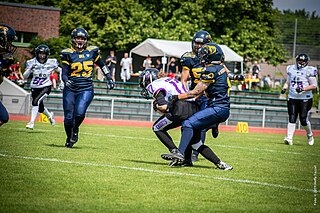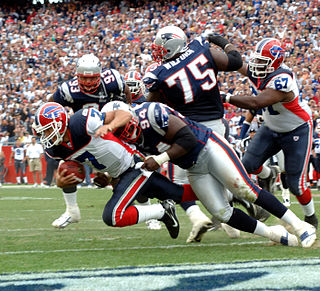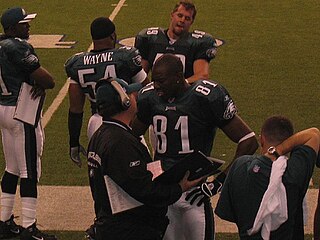Related Research Articles

Canadian football, or simply football, is a sport in Canada in which two teams of 12 players each compete on a field 110 yards (101 m) long and 65 yards (59 m) wide, attempting to advance a pointed oval-shaped ball into the opposing team's end zone.

The end zone is the scoring area on the field, according to gridiron-based codes of football. It is the area between the end line and goal line bounded by the sidelines. There are two end zones, each being on the opposite side of the field. It is bordered on all sides by a white line indicating its beginning and end points, with orange, square pylons placed at each of the four corners as a visual aid. Canadian rule books use the terms goal area and dead line instead of end zone and end line respectively, but the latter terms are the more common in colloquial Canadian English. Unlike sports like association football and ice hockey which require the ball/puck to pass completely over the goal line to count as a score, both Canadian and American football merely need any part of the ball to break the vertical plane of the outer edge of the goal line.

A fumble in gridiron football occurs when a player who has possession and control of the ball loses it before being downed (tackled), scoring, or going out of bounds. By rule, it is any act other than passing, kicking, punting, or successful handing that results in loss of ball possession by a player.

A touchdown is a scoring play in gridiron football. Whether running, passing, returning a kickoff or punt, or recovering a turnover, a team scores a touchdown by advancing the ball into the opponent's end zone. More specifically a touchdown is when any part of the football, in the possession of an offensive player, crosses the goal line while the player, as well as the ball, is inbounds, and the player is upright. In order for a player to be down, any part of their body other than their hands or feet must touch the ground. If a player falls down without being contacted by a defensive player, whether or not they are down varies by league.

Gridiron football, also known as North American football, or in North America as simply football, is a family of football team sports primarily played in the United States and Canada. American football, which uses 11 players, is the form played in the United States and the best known form of gridiron football worldwide, while Canadian football, which uses 12 players, predominates in Canada. Other derivative varieties include arena football, flag football and amateur games such as touch and street football. Football is played at professional, collegiate, high school, semi-professional, and amateur levels.

A down is a period in which a play transpires in gridiron football. The down is a distinguishing characteristic of the game compared to other codes of football but is synonymous with a "tackle" in rugby league. The team in possession of the football has a limited number of downs to advance ten yards or more towards their opponent's goal line. If they fail to advance that far, possession of the ball is turned over to the other team. In most situations if a team reaches their final down, they will punt to their opponent, which forces their opponent to begin their drive from further down the field; if they are in range, they might instead attempt to score a field goal.
In American football, a touchback is a ruling that is made and signaled by an official when the ball becomes dead on or behind a team's own goal line and the opposing team gave the ball the momentum, or impetus, to travel over or across the goal line but did not have possession of the ball when it became dead. Since the 2018 season, touchbacks have also been awarded in college football on kickoffs that end in a fair catch by the receiving team between its own 25-yard line and goal line. Starting for the 2023 season, the NFL adopted the same rules as college football in regards to awarding touchbacks on kickoffs that end in a fair catch. Such impetus may be imparted by a kick, pass, fumble, or in certain instances by batting the ball. A touchback is not a play, but a result of events that may occur during a play. A touchback is the opposite of a safety with regard to impetus since a safety is scored when the ball becomes dead in a team's end zone after that team — the team whose end zone it is — caused the ball to cross the goal line.
This is a glossary of terms used in Canadian football. The Glossary of American football article also covers many terms that are also used in the Canadian version of the game.
- Legally positioned at the kick-off or the snap. On kick-offs, members of the kicking team must be behind the kick-off line; members of the receiving team must be at least 10 yards from the kick-off line. On scrimmages, at the snap the offence must be behind the line of scrimmage; the defence must be at least one yard beyond the line of scrimmage.
- A player of the kicking team who can legally recover the kick. The kicker and any teammates behind the ball at the time of the kick are onside. Thus on kick-offs all players of the kicking team are onside, but on other kicks usually only the kicker is. The holder on a place kick is not considered onside.
- A defensive position on scrimmages, also called free safety. Typical formations include a single safety, whose main duty is to cover wide receivers. See also defensive back.
- A two-point score. The defence scores a safety when the offence carries or passes the ball into its own goal area and then fails to run, pass, or kick the ball back into the field of play; when this term is used in this sense, it is also referred to as a safety touch.

American and Canadian football are gridiron codes of football that are very similar; both have their origins partly in rugby football, but some key differences exist between the two codes.
Strategy is a major part of American football.

Gameplay in American football consists of a series of downs, individual plays of short duration, outside of which the ball is or is not in play. These can be plays from scrimmage – passes, runs, punts or field goal attempts – or free kicks such as kickoffs and fair catch kicks. Substitutions can be made between downs, which allows for a great deal of specialization as coaches choose the players best suited for each particular situation. During a play, each team should have no more than 11 players on the field, and each of them has specific tasks assigned for that specific play.
In gridiron football, clock management is an aspect of game strategy that focuses on the game clock and/or play clock to achieve a desired result, typically near the end of a match. Depending on the game situation, clock management may entail playing in a manner that either slows or quickens the time elapsed from the game clock, to either extend the match or hasten its end. When the desired outcome is to end the match quicker, it is analogous to "running out the clock" seen in many sports. Clock management strategies are a significant part of American football, where an elaborate set of rules dictates when the game clock stops between downs, and when it continues to run.

A kickoff is a method of starting a drive in gridiron football. Additionally, it may refer to a kickoff time, the scheduled time of the first kickoff of a game. Typically, a kickoff consists of one team – the "kicking team" – kicking the ball to the opposing team – the "receiving team". The receiving team is then entitled to return the ball, i.e., attempt to advance it towards the kicking team's end zone, until the player with the ball is tackled by the kicking team, goes out of bounds, scores a touchdown, or the play is otherwise ruled dead. Kickoffs take place at the start of each half of play, the beginning of overtime in some overtime formats, and after scoring plays.

In gridiron football, the safety or safety touch is a scoring play that results in two points being awarded to the scoring team. Safeties can be scored in a number of ways, such as when a ball carrier is tackled in his own end zone or when a foul is committed by the offense in its own end zone. After a safety is scored in American football, the ball is kicked off to the team that scored the safety from the 20-yard line; in Canadian football, the scoring team also has the options of taking control of the ball at its own 35-yard line or kicking off the ball, also at its own 35-yard line. The ability of the scoring team to receive the ball through a kickoff differs from the touchdown and field goal, which require the scoring team to kick the ball off to the scored-upon team. Despite being of relatively low point value, safeties can have a significant impact on the result of games, and Brian Burke of Advanced NFL Stats estimated that safeties have a greater abstract value than field goals, despite being worth a point less, due to the field position and reclaimed possession gained off the safety kick.

A comparison of American football and rugby union is possible because of the games' shared origins, despite their dissimilarities.

The rectangular field of play used for American football games measures 100 yards (91.44 m) long between the goal lines, and 160 feet (48.8 m) wide. The field may be made of grass or artificial turf. In addition, there are end zones extending another 10 yards (9.144 m) past the goal lines to the "end lines", for a total length of 120 yards (109.7 m). When the "football field" is used as unit of measurement, it is usually understood to mean 100 yards (91.44 m), although technically the full length of the official field, including the end zones, is 120 yards (109.7 m). The total area of the field is 57,600 sq ft or 5,350 m2. There is a goal centered on each end line, with a crossbar 10 feet (3.0 m) above the ground and goalposts 18 feet 6 inches (5.64 m) apart extending at least 35 feet (11 m) above the crossbar. Between the goal lines, additional lines span the width of the field at 5-yard intervals. This appearance led to the use of the term gridiron in the 1880s. For a few years in the early 20th century, lines perpendicular to the lines at 5-yard intervals spanned the length of the field, giving it a checkerboard-like appearance.
The following terms are used in American football, both conventional and indoor. Some of these terms are also in use in Canadian football; for a list of terms unique to that code, see Glossary of Canadian football.

In sports, out of bounds refers to being outside the playing boundaries of the field. The legality of going out of bounds, and the ease of prevention, vary by sport. Sports that use this term include American football, Canadian football, field lacrosse, basketball, rugby union, rugby league, and association football.

In gridiron football, a punt is a kick performed by dropping the ball from the hands and then kicking the ball before it hits the ground. The most common use of this tactic is to punt the ball downfield to the opposing team, usually on the final down, with the hope of giving the receiving team a field position that is more advantageous to the kicking team when possession changes. The result of a typical punt, barring any penalties or extraordinary circumstances, is a first down for the receiving team. A punt is not to be confused with a drop kick, a kick after the ball hits the ground, now rare in both American and Canadian football.
References
- ↑ "Football End Line". www.rookieroad.com.
- ↑ "2023 NFL Rulebook | NFL Football Operations". operations.nfl.com. Retrieved 2024-02-05.
- ↑ Martin, Coach (2022-06-20). "What is a Safety in Football? (Full Explanation)". Football Advantage. Retrieved 2024-02-05.
- ↑ "Football Goal Post". www.rookieroad.com.